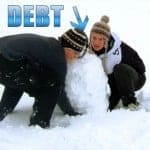“The wicked borroweth, and payeth not again: but the righteous showeth mercy, and giveth.” Psalm 37:21
One principle that is important in the area of personal finance is integrity, and making sure that when you borrow money, you’re paying it back.
The reasons that people will find themselves in debt vary, and it isn’t always easy to understand why we do the things we do.
We see that beautiful 65″ QLED screen and realize that we just HAVE to have it.
Or that new super-thin laptop you saw on that tech site – you know just how you would use it. So you bought it.
Other times the reasons for debt may not be within your control. Maybe you’ve had an illness, or a natural disaster hit your area, but something caused your situation to get out of hand. The bills started piling up, and now you need to pay back that money that you’ve borrowed.
No matter where the debt came from, the fact is – it is there and now it needs to be paid off? Where to start?
Dump Debt Using The Debt Snowball
Years ago I had larger debts that I had accumulated, it can be frustrating when you’ve got all these huge bills, and paying off small amounts on those large debts don’t seem to get you anywhere. It can be frustrating to the point that you just give up on actually making anything more than the minimum payments.
Financial guru Dave Ramsey in his book Total Money Makeover talks about how getting out of debt is often more about getting your mental attitude straight, than about actually getting the numbers right when paying the debt.
He talks about his debt snowball concept:
Personal finance is 80 percent behavior and 20 percent head knowledge. The Debt Snowball is designed the way it is because we are more concerned about modifying behavior than correct mathematics…Being a certified nerd, I always used to start with making the math work. I have learned the math does need to work, but sometimes motivation is more important than math. This is one of those times.

Getting out of debt can be more psychological than rational. The debt snowball concept makes it so that you’re paying off the debts with the smallest balance first. That way you can see yourself making progress.
The psychological benefit of actually seeing that number on the balance sheet disappear is priceless.
How The Debt Snowball Works
JD over at GetRichSlowly.com describes how the debt snowball works:
- Order your debts from lowest balance to highest balance.
- Designate a certain amount of money to pay toward debts each month.
- Pay the minimum payment on all debts except the one with the lowest balance.
- Throw every other penny at the debt with the lowest balance.
- When that debt is gone, do not alter the monthly amount used to pay debts, but throw all you can at the debt with the next-lowest balance.
The debt that I accumulated during my college and early working years included credit card debt from overseas trips, debt on my wife’s engagement ring, car payments, student loan payments, and other various debts.
While I didn’t realize it at the time I was employing some of the very tactics that are described in this debt snowball method. I paid off the smaller debts first, then worked my way up until sometime a couple of years ago all of our debts were paid off, excluding our home mortgage (which we’re working on now).
So I know this works!
Snowflaking Your Way Out Of Debt
An extension of the debt snowball method is the “Snowflaking” idea proposed by another blogger, Jaimie with Paid Twice.
The concept is that you take small amounts of money that you earn or save during the week and apply them to your debt.
Save $5 with a coupon at the pump? Apply it to your credit card debt!
Earn $15 selling a book on ebay? Apply it to that credit card debt.
She explains that snowflakes are:
small amounts of money saved or earned that are applied directly to debt or into savings before they melt away into who knows where.
She continues with her five Golden rules for snowflaking:
- Snowflake early and often: This is really the overarching theme to snowflaking success. Snowflake whatever you can whenever you can. The more often you snowflake, the more it will become a habit to look for snowflakes. Identify them wherever you can and keep making those snowflake payments. The more ingrained the habit, the more you will find.
- No amount is too small to be a snowflake: I have snowflaked as little as $1.04 and as much as $1313.74 and everything in between. Any amount can be a snowflake, and any amount can make a difference. Especially when you are dealing with a debt that has interest charged to it (which most are) or putting money into savings earning interest, don’t wait to get to a certain amount before applying that snowflake. Whatever the amount – snowflake it.
- Anything can be a snowflake: Did you just save $3.40 at the grocery store using coupons? Did you just spend $5 less on shoes than you budgeted? Snowflake it. Just like any amount can be a snowflake, snowflakes can come from any source. They don’t have to be from a specific income stream or a specific budget item. Find them wherever you can.
- Snowflake as immediately as possible: When you save or earn money to snowflake, do it immediately. Transfer it to your savings account or make an immediate payment to debt. If you can’t do it immediately, keep very careful track of the exact amounts and pay them or save them as soon as possible. Right now, I am limited to 4 electronic payments a month on my credit card, so I keep track of all my snowflakes each week and make a payment once a week from my checking account. My past credit card, I could pay as often as I wanted, so I would send an electronic payment as soon as I could get to the computer after finding a snowflake. Don’t give yourself a chance to spend the snowflake on something else.
- Keep track of your snowflakes to use for motivation: A lot of small amounts may not seem like a whole lot if you don’t keep track of them. As well as watching your debt total shrink or your savings total rise, keep track of the snowflakes themselves. Keep a running total once a month to see how much all those small amounts add up to. You may be surprised, I sure was. It may not seem like much while you are doing it but a lot of little bits add up to one big chunk of debt demolished or savings achieved.
Hopefully some of these ideas can help you on your road to dumping debt and becoming debt free. Let’s start that budget and start on the road to financial freedom! Good luck!



Another tip to get out of debt fast is try to consolidate your debt onto a single card with an interest rate lower than what your current cards are charging you. You’ll lower your monthly payments and pay off cards quicker.